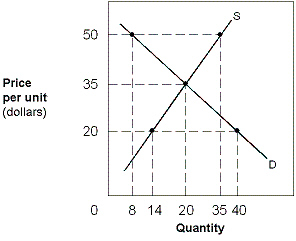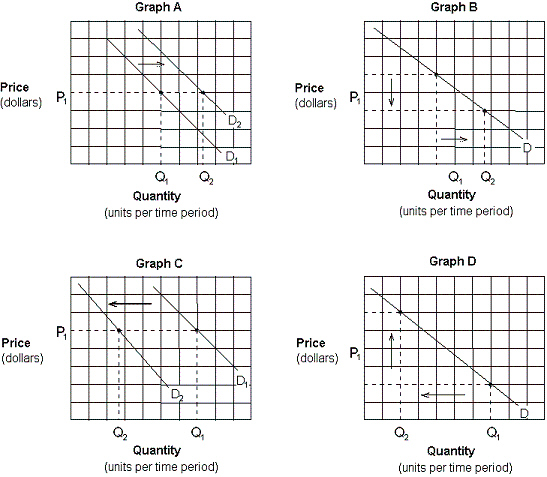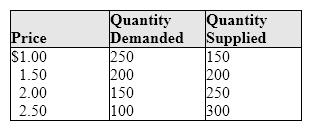A) not change; only quantity demanded will change.
B) increase, because the goods are substitutes.
C) decrease, because the goods are substitutes.
D) decrease, because the goods are complements.
E) increase, because the goods are complements.
Correct Answer

verified
Correct Answer
verified
Multiple Choice
Exhibit 3-9 Demand and supply curves  In Exhibit 3-9, if the market price is $50,
In Exhibit 3-9, if the market price is $50,
A) this market will be in equilibrium.
B) a shortage of 27 units would result.
C) the price is below the equilibrium price.
D) a surplus of 26 units would result.
E) a surplus of 27 units would result.
Correct Answer

verified
Correct Answer
verified
True/False
Higher milk prices reduce the demand for milk.
Correct Answer

verified
Correct Answer
verified
Multiple Choice
Which of the following will increase the supply of a good?
A) An increase in the price of another good that producers could produce.
B) A lower price paid for resources used in the production of the good.
C) A decrease in the number of sellers.
D) An increase in taxes paid to the government by producers.
Correct Answer

verified
Correct Answer
verified
Multiple Choice
Which of the following will cause the demand curve for a good to shift to the right?
A) Decrease in income for a normal good.
B) Increase in the price of a complementary good.
C) Decrease in the price of the good.
D) Increase in the price of a substitute good.
E) Expectation of a future price decline.
Correct Answer

verified
Correct Answer
verified
Multiple Choice
For a normal good, an increase in consumer income will cause the market demand for the product to:
A) decrease, which is a shift to the left of the demand curve.
B) decrease, which is a shift to the right of the demand curve.
C) increase, which is a shift to the left of the demand curve.
D) increase, which is a shift to the right of the demand curve.
Correct Answer

verified
Correct Answer
verified
Multiple Choice
If two goods are complementary, a(n) :
A) decrease in the price of one product will cause a decrease in the demand for the other product.
B) decrease in the price of one product will cause an increase in the demand for the other product.
C) increase in the price of one product will cause an increase in the supply of the other product.
D) increase in the price of one product will cause a decrease in the supply of the other product.
E) increase in the price of one product will cause an increase in the demand for the other product.
Correct Answer

verified
Correct Answer
verified
True/False
If pork and beans is an inferior good, other things being equal, an increase in consumer income will decrease the demand for pork and beans.
Correct Answer

verified
Correct Answer
verified
Multiple Choice
If equilibrium is present in a market:
A) there is either a shortage or a surplus.
B) the quantity demanded equals quantity supplied.
C) the quantity demanded exceeds quantity supplied.
D) the quantity supplied exceeds quantity demanded.
Correct Answer

verified
Correct Answer
verified
True/False
Equilibrium in a market exists when there is neither a surplus nor a shortage of the item.
Correct Answer

verified
Correct Answer
verified
Multiple Choice
Exhibit 3-3 Demand curves  Assume that crackers and soup are complementary goods. Which of the graphs in Exhibit 3-3 depicts the effect of a promotional discount that decreases the price of crackers on the demand for soup?
Assume that crackers and soup are complementary goods. Which of the graphs in Exhibit 3-3 depicts the effect of a promotional discount that decreases the price of crackers on the demand for soup?
A) Graph A.
B) Graph B.
C) Graph C.
D) Graph D.
Correct Answer

verified
Correct Answer
verified
Multiple Choice
Assume Qs represents the quantity supplied at a given price and Qd represents the quantity demanded at the same given price. Which of the following market conditions produce a downward movement of the price?
A) Qs = 1,000, Qd = 750.
B) Qs = 750, Qd = 750.
C) Qs = 750, Qd = 1,000.
D) Qs = 1,000, Qd = 1,000.
Correct Answer

verified
Correct Answer
verified
Multiple Choice
A leftward shift of a supply curve is called a(n) :
A) decrease in demand.
B) increase in supply.
C) decrease in supply.
D) increase in quantity supplied.
E) decrease in quantity supplied.
Correct Answer

verified
Correct Answer
verified
Multiple Choice
How will an increase in lumber prices influence the home construction market?
A) The demand for newly constructed homes will increase.
B) The demand for newly constructed homes will decrease.
C) The supply of newly constructed homes will increase.
D) The supply of newly constructed homes will decrease.
Correct Answer

verified
Correct Answer
verified
Multiple Choice
Coffee and tea are:
A) complements.
B) substitutes.
C) inferior goods.
D) unrelated goods.
E) nonmarket goods.
Correct Answer

verified
Correct Answer
verified
Multiple Choice
Complementary goods are goods:
A) that are consumed jointly.
B) that are consumed one in place of the other.
C) for which demand increases when the price of its complementary goods increases.
D) for which demand decreases when the price of its complementary goods decreases.
E) that are inversely related.
Correct Answer

verified
Correct Answer
verified
Multiple Choice
At a price of $5, Sam buys 10 units of a product; when the price increases to $6, Sam buys 8 units. Martha says Sam's demand has decreased. Is Martha correct?
A) Yes, Martha is correct. Sam's demand has decreased.
B) No, Martha is incorrect. Sam's demand has increased.
C) No, Martha is incorrect. Sam's quantity demanded has decreased, and his demand has not changed.
D) No, Martha is incorrect. Sam's quantity demanded has increased, and his demand has increased.
E) No, Martha is incorrect. Sam's demand has increased, and his quantity demanded has decreased.
Correct Answer

verified
Correct Answer
verified
Multiple Choice
Assuming that clothing is a normal good, an increase in consumer income, other things being equal, would:
A) increase the demand for clothing.
B) decrease the demand for clothing.
C) increase the quantity of clothing demanded.
D) decrease the quantity of clothing demanded
Correct Answer

verified
Correct Answer
verified
Multiple Choice
A baby boom will have what immediate effect on the disposable diaper market?
A) Supply decreases.
B) Supply increases.
C) Demand decreases.
D) Demand increases.
E) Supply and demand remains the same.
Correct Answer

verified
Correct Answer
verified
Multiple Choice
Exhibit 3-12 Supply and demand data  In Exhibit 3-12, which of the following occurs at a price of $1.00?
In Exhibit 3-12, which of the following occurs at a price of $1.00?
A) A shortage puts a downward pressure on price.
B) Quantity demanded exceeds quantity supplied, putting upward pressure on price.
C) Quantity supplied exceeds quantity demanded, putting upward pressure on price.
D) The surplus would be so small that there would be only slight upward pressure on price.
Correct Answer

verified
Correct Answer
verified
Showing 141 - 160 of 348
Related Exams